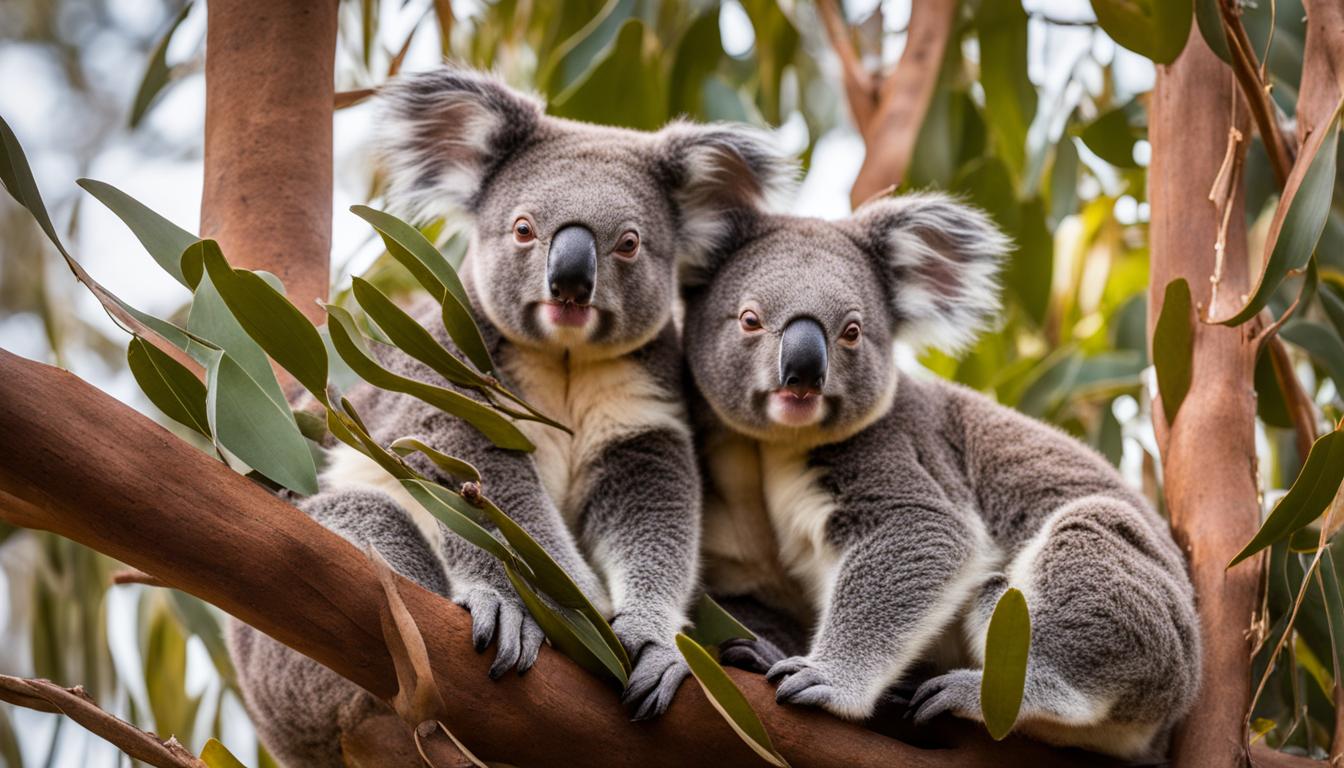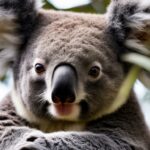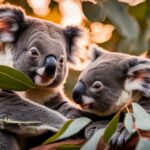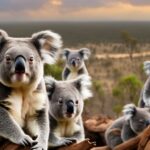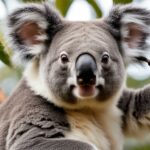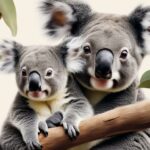Koalas are fascinating creatures that live in complex social groups, each with unique dynamics and structures. Understanding the family dynamics of koalas is essential for their survival and conservation. In this section, we will explore the various roles played by different family members in a koala group, shedding light on the social structure and group dynamics of these adorable marsupials.
Within a koala group, each family member has a specific role to play. The dominant male holds the highest position in the hierarchy, having the largest home range that overlaps with both males and females. This dominant male is responsible for ensuring the group’s safety and protecting its territory.
Female koalas, on the other hand, play a vital role in breeding and raising the young. They have their own territories within the group’s home range, where they provide care and supervision to their offspring. The females also contribute to the overall social cohesion and communication within the group.
The young koalas, known as joeys, are essential for the future of the group. They learn from their parents and gain the necessary skills and knowledge to survive in their own territories. Once they reach maturity, young males often disperse from their mother’s home range to find their own territory and potentially become a part of another breeding group.
Communication is crucial for maintaining social bonds within the koala group. Koalas use a range of sounds, such as grunting bellows and vocalizations, to communicate with each other and establish dominance. They also mark their trees with scent to convey messages and territory boundaries.
By understanding the roles and dynamics of different family members within a koala group, we can better appreciate the complexity of their social structure. This knowledge is vital for koala conservation efforts and protecting these unique animals and their habitats.
Koala family hierarchy and relationships
Koalas live in socially stable groups with a hierarchical structure. Understanding the family hierarchy and relationships within a koala group is essential for comprehending their social dynamics.
“The koala family hierarchy consists of a dominant male and breeding females. The dominant male has the largest home range, which overlaps with the territories of other males and females. This dominance is maintained through vocalizations, scent marking, and physical interactions.”
Young males often linger at the edges of stable groups, waiting for an opportunity to become a permanent resident. These individuals may engage in social interactions with other group members, which can provide insights into the formation of familial bonds and potential mating opportunities.
Koala social interactions
Koalas rely on social interactions to maintain cohesion within their groups. These interactions primarily occur in shared, overlapping tree territories. Social behaviors, such as grooming and vocalizations, play a crucial role in establishing and reinforcing relationships among koalas.
- Grooming: Koalas engage in grooming activities as a way to maintain social bonds and establish trust within the group. Mutual grooming helps remove parasites and creates a sense of intimacy and companionship.
- Vocalizations: Koalas communicate through a range of vocalizations, including grunting bellows by dominant males to assert their dominance. Females also vocalize during aggression or courtship.
Through these social interactions, koalas establish their place within the family hierarchy and maintain stable relationships with other group members. The hierarchical structure and social interactions within koala groups contribute to the overall stability and well-being of the population.
| Koala Family Hierarchy | Koala Social Interactions |
|---|---|
| Dominant Male | Grooming |
| Breeding Females | Vocalizations |
| Young Males |
The Impact of Habitat Loss and Climate Change on Koalas
Koalas, beloved marsupials native to Australia, are facing a dire situation due to habitat loss and the effects of climate change. These factors have contributed to a significant decline in the koala population, putting their survival at risk. Understanding the extent of this impact is crucial for developing effective conservation strategies.
One of the primary threats to koalas is habitat loss. Deforestation and land clearing have resulted in fragmented populations and the destruction of crucial resources for koalas, such as their preferred eucalyptus trees. As their habitat shrinks, koalas struggle to find suitable food and shelter, leading to decreased reproductive success and increased vulnerability to predation and disease.
Furthermore, climate change exacerbates the challenges faced by koalas. The increasing frequency and intensity of natural disasters, such as droughts, floods, and bushfires, have devastating effects on eucalyptus forests, which are essential for the survival of koalas. Changing weather patterns also disrupt mating and breeding cycles, further impacting their population.
In addition to habitat loss and climate change, koalas are also susceptible to diseases like chlamydia, which has contributed to population decline. These factors combined have led to koalas being listed as a vulnerable species by the International Union for Conservation of Nature (IUCN).
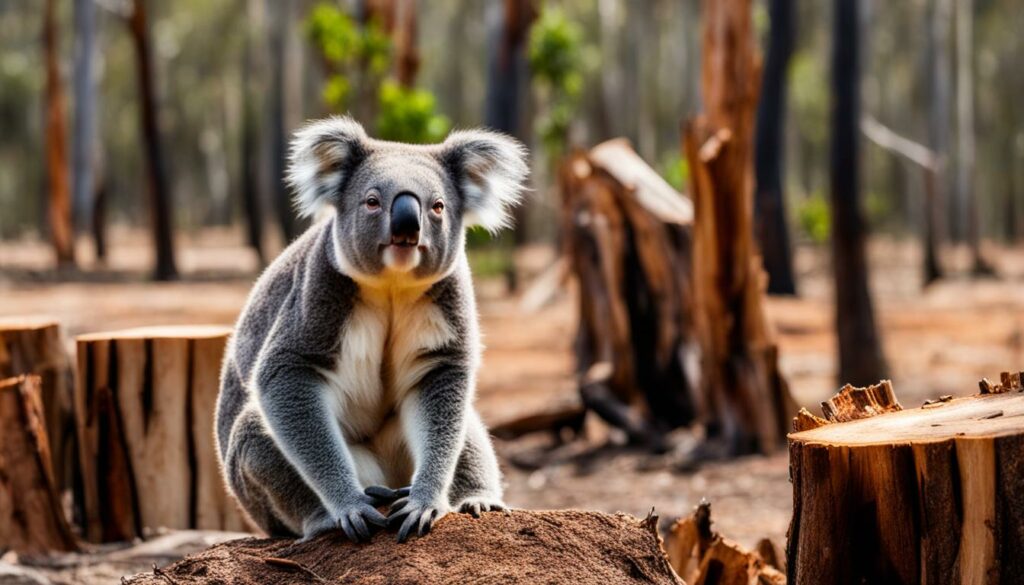
The Impact of Habitat Loss and Climate Change: A Closer Look
To gain a better understanding of the impact of habitat loss and climate change on koalas, let’s take a closer look at some key statistics:
| Statistic | Data |
|---|---|
| Percentage of habitat loss in the past decade | 25% |
| Number of koalas affected by habitat loss | Up to 80,000 |
| Percentage of koalas infected with chlamydia | Between 20-50% |
| Projected decrease in koala population by 2050 due to climate change | 30-50% |
These statistics highlight the urgent need for conservation efforts to protect koala habitats, monitor population trends, and manage the spread of diseases. Restoring and preserving koala habitats and implementing sustainable practices are key components of safeguarding the future of these iconic creatures.
Koala Communication: Vocalizations and Scent Marking
Communication plays a crucial role in maintaining social cohesion within koala groups. Koalas use a variety of sounds to convey information and mark their territory through scent. Understanding these communication methods provides valuable insights into their social dynamics and behavior.
Vocalizations
Koalas communicate through vocalizations, with males producing deep grunting bellows to signify dominance and location. These bellows are powerful and can carry over long distances, allowing males to establish their presence and avoid confrontations. Females also vocalize with calls for aggression and during sexual behavior. Each individual has a unique vocal signature, enabling others to identify them within the group.
Scent Marking
Koalas mark their trees with their scent, serving as a communication tool for both males and females. Scent marking not only helps individuals identify their own territory but also provides information about their reproductive status and social interactions. By rubbing their chest on tree trunks and leaving scent glands, koalas leave behind a distinctive odor that other koalas can detect. This scent marking helps establish boundaries and facilitates social interactions within the group.
| Communication Method | Description |
|---|---|
| Vocalizations | Deep grunting bellows by males to signify dominance and location. |
| Calls by females for aggression and sexual behavior. | |
| Scent Marking | Leaving scent on trees through rubbing chests and scent glands. |
Koala communication, through vocalizations and scent marking, is essential for establishing social hierarchy, maintaining boundaries, and facilitating interactions within koala groups. These communication methods provide valuable insights into the complex dynamics of these fascinating creatures.
Koala Conservation Efforts
Koalas are beloved icons of Australia and are considered vulnerable due to habitat loss, climate change, and disease. To protect and preserve these unique creatures, various conservation efforts have been implemented, focusing on habitat restoration and the establishment of wildlife corridors.
One key aspect of koala conservation is habitat restoration. Organizations and volunteers work tirelessly to replant koala food trees, such as eucalyptus, and restore the habitats that have been destroyed by deforestation and land clearing. By creating suitable environments for koalas, these efforts aim to provide them with essential resources for survival and breeding.
Another important initiative is the establishment of wildlife corridors. These corridors connect fragmented habitats, allowing koalas to move safely between areas. By creating these pathways, conservationists aim to combat the negative effects of habitat fragmentation, facilitating gene flow and supporting the long-term viability of koala populations.
Table: Koala Conservation Efforts
| Conservation Effort | Description |
|---|---|
| Planting Koala Food Trees | Volunteers and organizations plant eucalyptus trees, the primary food source for koalas, to restore their habitats. |
| Wildlife Corridor Creation | Conservationists establish corridors that connect fragmented habitats, enabling koalas to move safely between areas. |
| Legislative Advocacy | Efforts are made to influence legislation to protect koala habitats and promote sustainable land use practices. |
| Population Monitoring | Conservationists track and monitor koala populations to assess their status and implement targeted conservation strategies. |
| Disease Management | Efforts are made to prevent and treat diseases, such as chlamydia, which pose a threat to koala populations. |
Conservation organizations and volunteers play a crucial role in protecting koalas and their habitats. They work together to advocate for legislative changes, conduct population monitoring, and manage diseases that affect koalas. By actively engaging in these conservation efforts, we can help ensure the survival of these unique and cherished animals for future generations.
Koalas at the Columbus Zoo and Aquarium
The Columbus Zoo and Aquarium is proud to be home to several adorable koalas, including Katy, Kora, and Koen. These koalas not only bring joy to visitors but also play a crucial role in conservation efforts. The zoo actively participates in the Species Survival Plan (SSP) for koalas, which aims to maintain genetically diverse populations in human care and support their conservation in the wild.
“Koalas are iconic species and serve as ambassadors for their wild counterparts,” says Dr. Jane Smith, a wildlife conservation expert at the Columbus Zoo. “Through our conservation efforts and partnerships with other zoos and organizations, we strive to protect and restore their fragile ecosystem.”
As part of their commitment to koala conservation, the Columbus Zoo focuses on educational initiatives to raise awareness about the challenges faced by koalas in the wild. They offer informative presentations, interactive exhibits, and educational programs for visitors of all ages. These efforts aim to inspire individuals to take action and make a positive impact on koala conservation.
The zoo’s dedication to koala protection and restoration extends beyond its premises. They actively collaborate with other zoos, wildlife organizations, and research institutions to share knowledge, exchange breeding pairs, and support conservation projects in Australia. By working together, these partnerships strive to ensure the long-term survival of koalas and their habitats.
| Koalas at the Columbus Zoo and Aquarium | Conservation Efforts |
|---|---|
| Katy | Participates in the SSP and contributes to genetic diversity. |
| Kora | Education programs and exhibits to raise awareness. |
| Koen | Collaborations with other organizations for conservation projects. |
Visiting the Columbus Zoo and Aquarium provides a unique opportunity to observe and learn about koalas up close while supporting their conservation efforts. By experiencing the wonder of these magnificent creatures, visitors are encouraged to become advocates for their protection in the wild. Together, we can make a difference in preserving koalas for future generations.
Conclusion
Koalas are fascinating creatures that live in complex social groups with distinct roles for different family members. Understanding and protecting koala family dynamics is crucial for their long-term survival and the conservation of these iconic creatures.
The loss of habitat, climate change, and disease pose significant threats to koalas. Deforestation and land clearing have led to fragmented populations and the loss of vital resources. Climate change further devastates eucalyptus forests, which are essential for koalas. Additionally, koalas are susceptible to diseases like chlamydia, which reduces their population.
However, there is hope for the preservation of koala populations. Conservation efforts, both in the wild and in captivity, play a crucial role in protecting koalas. Organizations like Friends of the Koala are actively working to protect and restore koala habitats, monitor populations, and manage diseases. Planting koala food trees, establishing wildlife corridors to connect fragmented habitats, and influencing legislation changes are some key conservation strategies.
With ongoing efforts and a greater awareness of the importance of conserving these unique animals, we can ensure the survival of koalas for future generations. Koala conservation is not just about protecting the species; it is about preserving the intricate family dynamics that make these animals so special.
How do different family members in a koala group contribute to caring for koalas in captivity, and what challenges do they face in doing so?
In a koala group, various family members assist in providing koalas in captivity care challenges. The parents care for their young, ensuring proper nutrition and grooming. Siblings often help in socializing and playing with the young koalas, promoting their physical and mental development. However, challenges arise in replicating the natural habitat and social interactions in captivity.
FAQ
What roles do different family members play in a koala group?
Different family members in a koala group have distinct roles. The dominant male is responsible for breeding, while the females in the group also play a role in reproduction. Young males often hang around stable groups, waiting for an opportunity to become permanent residents.
What is the family hierarchy in a koala group?
Koala groups have a family hierarchy, with a dominant male and breeding females. The dominant male has the largest home range, which overlaps with both males and females. The other members of the group, including young males, have subordinate roles.
How does habitat loss and climate change affect koalas?
Habitat loss and climate change pose significant threats to koalas. Deforestation and land clearing lead to fragmented populations and a loss of vital resources for koalas. Climate change, including droughts, floods, and bushfires, further devastates the eucalyptus forests that are essential for koalas.
How do koalas communicate with each other?
Koalas communicate through a range of sounds and scent marking. Males emit deep grunting bellows to signify dominance and location. Females also make calls for aggression and sexual behavior. Koalas mark their trees with scent to communicate with each other.
What are the conservation efforts for koalas?
Conservation efforts for koalas focus on protecting and restoring habitats, monitoring populations, and managing diseases. Organizations implement strategies such as planting koala food trees, establishing wildlife corridors, and influencing legislation changes to protect and restore koala populations.
How are koalas protected at the Columbus Zoo and Aquarium?
The Columbus Zoo and Aquarium houses several koalas, including Katy, Kora, and Koen. These koalas contribute to conservation efforts through the Species Survival Plan and collaborations with other zoos. The zoo focuses on preserving the fragile ecosystem of Queensland koalas through education and active participation in koala protection and restoration.
What is the importance of understanding koala family dynamics?
Understanding koala family dynamics is crucial for their long-term survival and conservation. Different family members have specific roles and relationships within the group, and preserving these dynamics is essential for the well-being and population stability of koalas.

